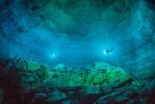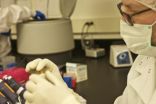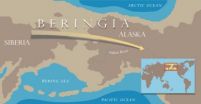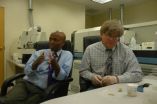(Press-News.org) This news release is available in Spanish and Arabic.
The discovery of a near-complete human skeleton in a watery cave in Mexico is helping scientists answer the question, "Who were the first Americans?" The finding, reported in the 16 May issue of the journal Science, sheds new light on a decades-long debate among archaeologists and anthropologists.
Deciphering the ancestry of the first people to populate the Americas has been a challenge.
On the basis of genetics, modern Native Americans are thought to descend from Siberians who moved into eastern Beringia (the landmass connecting Asia and North America) between 26,000 and 18,000 years ago. These people, the earliest Americans, then spread southward.
Despite widespread support for this idea, the ancestry of the earliest Americans is still debated because the facial features of the oldest American skeletons don't look much like those of modern Native Americans.
"Modern Native Americans closely resemble people of China, Korea, and Japan," James Chatters, lead author on the study, said, "but the oldest American skeletons do not." They have longer, narrower crania than later Native Americans, and smaller, shorter faces, too -- more closely resembling modern peoples of Africa, Australia, and the Southern Pacific Rim. "This has led to speculation that perhaps the first Americans and Native Americans came from different homelands," Chatters continued, "or migrated from Asia at different stages in their evolution."
Complicating the puzzle, it's been very difficult to find intact Paleoamerican skeletons for study.
"Paleoamerican skeletons are rare for several reasons," Chatters explained. "The people themselves were few; they were highly nomadic and seem to have buried or cremated the dead where they fell, making the locations of graves unpredictable; also, geologic processes have destroyed or deeply buried their graves."
Meanwhile, those skeletal remains that have been unearthed are lacking, often only fragments, and most estimated to be younger than 10,000 years old. (The earliest Americans reached the continent farther back in time than that.)
Now, however, Chatters and colleagues report the discovery of a near-complete Late Pleistocene-age human skeleton. It was hidden deep in a submerged chamber in the Sac Actun cave system on Mexico's Eastern Yucatán Peninsula.
"Hoyo Negro is a more than 100-foot-deep, bell-shaped, water-filled void about the size of a professional basketball arena deep inside a drowned cave system," Chatters said. "Only technical cave divers can reach the bottom. First they must climb down a 30-foot ladder in a nearby sinkhole; then they swim along 200 feet of tunnel to the pit rim before making a final 100-foot drop. The divers are the astronauts of this project; we scientists are their mission control."
Like nearby caves, Hoyo Negro was accessible only via sinkhole; people and animals fell in and were trapped. Then, starting about 10,000 years ago, global glaciers melted, filling the caves with water. In addition to the near-complete human skeleton, the researchers found the remains of 26 large mammals, including extinct taxa such as sabertooths and gomphotheres.
The nearly-intact skeleton was that of a small human female about 15 or 16 years old. Based on radiocarbon dating of tooth enamel and analyses of mineral deposits on her bones, the researchers inferred her remains to be at least 12,000 years old.
She possesses the unique craniofacial morphology of the earliest Americans, but to understand more about her ancestry and its potential linkage to modern Native Americans, the researchers extracted DNA from one of her molars. "We tried a DNA extraction on the outside chance some fragments might remain," Chatters said. "I was shocked when we actually got intact DNA."
He and colleagues analyzed the girl's mitochondrial DNA (mtDNA), a useful tool for examining the relatedness of populations. Their analysis revealed a haplotype common to modern Native Americans, subhaplogroup D1. This genetic signature occurs only in the Americas, likely having developed in Beringia after populations there split from other Asians.
The sample shows that individuals of the Pleistocene era with Beringian-derived mtDNA traveled far and wide through the Americas, all the way down to Mexico, for example.
Critically, it shows that despite differences in craniofacial form, this early American woman was related to modern Native Americans; the differences in craniofacial form are probably best explained as evolutionary changes that happened after the divergence of Beringians from their Siberian ancestors, the authors say.
Their work suggests that America was not colonized by separate migration events from different parts of Eurasia. Rather, the earliest Americans represent an early population expansion out of Beringia. This aligns with the hypothesis that both Paleoamericans and Native Americans derive from a single source population.
Chatters and colleagues were delighted with their find: "This project is exciting on so many fronts: the beautiful cave, the incredibly well-preserved animal skeletons, the completeness of the human skeleton, the success of our innovative dating approach. But for me," he said, "what is most exciting is that we finally have an answer, after 20 years, to a question that has plagued me since my first look at Kennewick Man: 'Who were the first Americans?'"
INFORMATION:
The American Association for the Advancement of Science (AAAS) is the world's largest general scientific society, and publisher of the journal, Science as well as Science Translational Medicine and Science Signaling. AAAS was founded in 1848, and includes some 261 affiliated societies and academies of science, serving 10 million individuals. Science has the largest paid circulation of any peer-reviewed general science journal in the world, with an estimated total readership of 1 million. The non-profit AAAS is open to all and fulfills its mission to "advance science and serve society" through initiatives in science policy; international programs; science education; and more. For the latest research news, log onto EurekAlert!, the premier science-news Web site, a service of AAAS.
This paper can be found at the following link on sciencemag.org when the embargo lifts: http://www.sciencemag.org/lookup/doi/10.1126/science.1252619
A skeleton clue to early American ancestry
Early American skeleton has genetic signature of modern Native Americans
2014-05-15
ELSE PRESS RELEASES FROM THIS DATE:
Oldest most complete, genetically intact human skeleton in New World
2014-05-15
WASHINGTON (May 15, 2014)—The skeletal remains of a teenage female from the late Pleistocene or last ice age found in an underwater cave in Mexico have major implications for our understanding of the origins of the Western Hemisphere's first people and their relationship to contemporary Native Americans.
In a paper released today in the journal Science, an international team of researchers and cave divers present the results of an expedition that discovered a near-complete early American human skeleton with an intact cranium and preserved DNA. The remains were found surrounded ...
WSU anthropologist leads genetic study of prehistoric girl
2014-05-15
PULLMAN, Wash.—For more than a decade, Washington State University molecular anthropologist Brian Kemp has teased out the ancient DNA of goose and salmon bones from Alaska, human remains from North and South America, and human coprolites—ancient poop—from Oregon and the American Southwest.
His aim: use genetics as yet another archaeological record offering clues to the identities of ancient people and how they lived and moved across the landscape.
As head of the team studying the DNA of Naia, an adolescent girl who fell into a Yucatan sinkhole some 12,000 years ago, he ...
Genetic study helps resolve years of speculation about first people in the Americas
2014-05-15
CHAMPAIGN, Ill. — A new study could help resolve a longstanding debate about the origins of the first people to inhabit the Americas, researchers report in the journal Science. The study relies on genetic information extracted from the tooth of an adolescent girl who fell into a sinkhole in the Yucatan 12,000 to 13,000 years ago.
The girl's remains were found alongside those of ancient extinct beasts that also fell into the "inescapable natural trap," as researchers described the sinkhole. The team used radiocarbon dating and analyzed chemical signatures in bones and ...
Dating and DNA show Paleoamerican-Native American connection
2014-05-15
Eastern Asia, Western Asia, Japan, Beringia and even Europe have all been suggested origination points for the earliest humans to enter the Americas because of apparent differences in cranial form between today's Native Americans and the earliest known Paleoamerican skeletons. Now an international team of researchers has identified a nearly complete Paleoamerican skeleton with Native American DNA that dates close to the time that people first entered the New World.
"Individuals from 9,000 or more years ago have morphological attributes -- physical form and structure -- ...
Genetic study confirms link between earliest Americans and modern Native-Americans
2014-05-15
AUSTIN, Texas — The ancient remains of a teenage girl found in an underwater Mexican cave establish a definitive link between the earliest Americans and modern Native Americans, according to a new study released today in the journal Science.
The study was conducted by an international team of researchers from 13 institutions, including Deborah Bolnick, assistant professor of anthropology at The University of Texas at Austin, who analyzed DNA from the remains simultaneously with independent researchers at Washington State University and the University of Illinois at Urbana-Champaign.
The ...
First 'heavy mouse' leads to first lab-grown tissue mapped from atomic life
2014-05-15
Scientists have created a 'heavy' mouse, the world's first animal enriched with heavy but non-radioactive isotopes - enabling them to capture in unprecedented detail the molecular structure of natural tissue by reading the magnetism inherent in the isotopes.
This data has been used to grow biological tissue in the lab practically identical to native tissue, which can be manipulated and analysed in ways impossible for natural samples. Researchers say the approach has huge potential for scientific and medical breakthroughs: lab-grown tissue could be used to replace heart ...
One of oldest human skeletons in North America is discovered
2014-05-15
Cave-diving scientist Patricia A. Beddows of Northwestern University is a member of an international team of researchers and cave divers this week announcing the discovery in an underwater Yucatán Peninsula cave of one of the oldest human skeletons found in North America.
Details of "Naia," a teenage girl who went underground to seek water and fell to her death in a large pit named Hoyo Negro ("black hole" in Spanish), will be published May 16 in the journal Science.
"The preservation of all the bones in this deep water-filled cave is amazing -- the bones are beautifully ...
Communicating with the world across the border
2014-05-15
Stanford, CA—All living cells are held together by membranes, which provide a barrier to the transport of nutrients. They are also the communication platform connecting the outside world to the cell’s interior control centers. Thousands of proteins reside in these cell membranes and control the flow of select chemicals, which move across the barrier and mediate the flux of nutrients and information. Almost all of these pathways work by protein handshakes--one protein “talking” to another in order to, for example, encourage the import of a needed nutrient, to block a compound ...
Quantum simulator gives clues about magnetism
2014-05-15
Assembling the puzzles of quantum materials is, in some ways, like dipping a wire hanger into a vat of soapy water, says CIFAR (Canadian Institute for Advanced Research) Fellow Joseph Thywissen (University of Toronto).
Long before mathematical equations could explain the shapes and angles in the soap foams, mathematicians conjectured that soap films naturally found the geometry that minimized surface area, thus solving the problem of minimal surfaces. They could be created simply by blowing soap bubbles.
At the University of Toronto's Ultracold Atoms Lab, Thywissen ...
UNM plays major role in establishing link between ancient and modern Native-Americans
2014-05-15
Her name is Naia, and for thousands and thousands of years, the skeleton of this young woman was buried underwater in an elaborate cave system in the Yucatan Peninsula after she had apparently fallen into what was then a dry deep pit.
Now, a team of researchers, including Professor Yemane Asmerom and Research Scientist Victor Polyak at the University of New Mexico's Department of Earth and Planetary Sciences, have accurately determined the age of the oldest-known, well-preserved human skeleton. Naia was one of the earliest inhabitants of the Americas and has helped resolve ...
LAST 30 PRESS RELEASES:
The perfect plastic? Plant-based, fully saltwater degradable, zero microplastics
Bias in data may be blocking AI’s potential to combat antibiotic resistance
Article-level metrics would provide more recognition to most researchers than journal-level metrics
Satiety’s little helper: Protein that supports appetite regulating protein identified
UF dives deep into predicting storm damage with computer models
A stormy ocean voyage yields insights on the global carbon cycle
Scientists identify first non-coding gene that controls cell size
Demonstration of altermagnetism in RuO₂ thin films -- A new magnetic material for the AI era
Penn researchers awarded $25M to conduct trial using smartphones to fight heart disease
PCORI awards funding for new patient-centered healthcare research
Exploring the origins of the universe: 145 low-noise amplifiers complete ALMA telescopes
Empress cicada wings help illuminate molecular structure
Using sound waves to detect helium
Time burden in patients with metastatic breast and ovarian cancer from clinic and home demands
Researchers discover bias in AI models that analyze pathology samples
Scientists ID potential way to prevent brain injuries from triggering Alzheimer's
MASTER 2nd Open Call: Execution period kick-off
Algae for health in food and pharma
Advanced microrobots driven by acoustic and magnetic fields for biomedical applications
Chicago health information leader recognized for raising CPR readiness and blood pressure awareness
The Intimate Animal, a new book from Kinsey Institute Executive Director Dr. Justin Garcia
When blue-collar workers lose union protection, they try self-employment
New video dataset to advance AI for health care
MEA-based graph deviation network for early autism syndrome signatures in human forebrain organoids
New modeling approach sheds light on rare gut disease
Study documents potentially hazardous flame retardants in firefighter gear
Can certain bacteria regulate aging of the immune system and its related alterations?
AI model helps diagnose often undetected heart disease from simple EKG
There are fewer online trolls than people think
Cell membrane fluctuations produce electricity
[Press-News.org] A skeleton clue to early American ancestryEarly American skeleton has genetic signature of modern Native Americans






